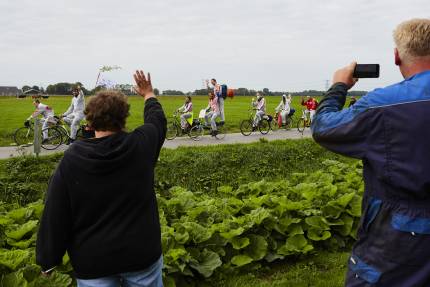
To an outsider Groningen feels so stereotypically Dutch. The houses quaint with big windows inviting the outside in. Immaculate lush green fields bordered by interlaced networks of canals that chop the landscape up into a rich green tapestry. Dotted with grazing sheep, cows and every now and then the elegant curve of a heron’s neck appearing above the long grass, one could easily mistake this tranquil first impression as reality.
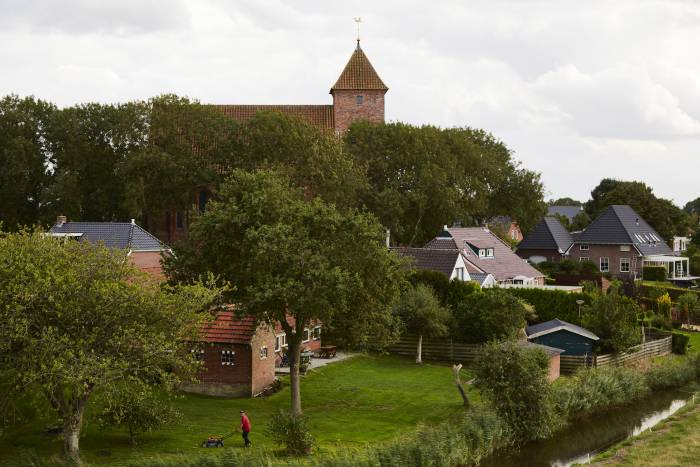
The village of Termunterzijl. Photo: Pierre Crom
This year’s action camp of climate grassroots network Code Rood took place on a small farm. It’s the property of a local resident in Groningen who has been active in the struggle to stop the gas drilling and make the oil giants Shell and Exxon, and the NAM (the local company that funnels profits to the Hague), pay for the damages they have caused over the 30 plus years that gas has been extracted from the region.
The fight against gas is a fight for justice
Despite working with gas related issues over the last year or so I found out some useful, yet worrying facts. For example, did you know that over a relatively short time period (20 years) the warming impact of fossil gas is 100 times worse than CO2, making it at least as problematic as coal. This is largely due to methane leakage across the supply chain.
In addition to the science, in Azerbaijan for example, where the Trans Adriatic Pipeline originates, the simple act of reporting about corruption associated with the gas extraction has left many journalists in jail. Farmers in Greece resisting land grabs by Italian company Bonatti have been violently attacked by private security firms, and in Albania compensation promised to people in the path of the pipe have been slow to non existent to materialise. The issue of gas, while directly impacting the climate, is also an issue of justice on many other levels. As is the fight against gas in Groningen.
The decades of gas extraction in the province and the resulting earthquakes has come at a huge cost. Property damage for the people living in the region and an ever present fear that at any time the roof of the house might fall in, has had an impact on people’s wellbeing, that is perhaps more severe than the financial burden of the property damage itself. At its heart, the local struggle in Groningen is one of justice.
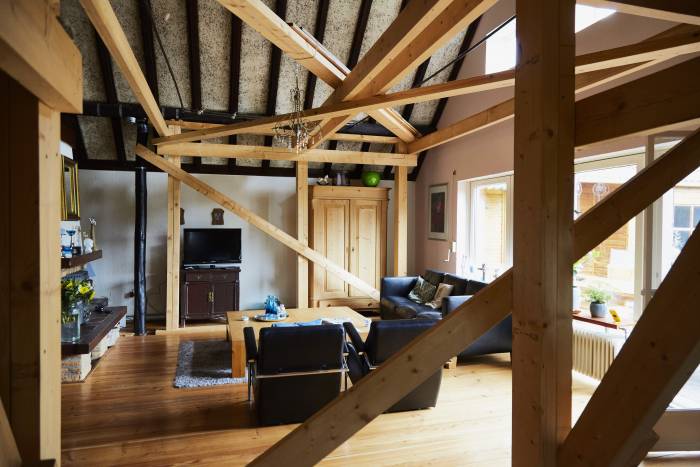
Reinforcements inside a house damaged by gas drilling earthquakes in the Groningen region. Photo: Pierre Crom
Walking into the camp, the mood was relaxed and jolly. Passing the buzz of the kitchen at the start of lunch and stopping briefly to take in what was a comprehensive cultural programme, I arrived at a workshop held by the international gastivists network. The workshop helped contextualise the local struggle in the expansion of gas infrastructure both across Europe and globally.
The Day of Action: blocking a gas terminal
The Code Rood action design was clearly influenced by the tactics of recent Ende Gelände mobilisations, which borrowed inspiration from the German anti-nuclear movement. By organising into ‘fingers’, each taking a different route – be that walking, boat, bike or train – we maximise the chances of as many people as possible making it to the target, by spreading those that want to try and stop us out over as large an area as possible.
Starting at around 8am the 200-strong ‘gold’ finger set off from the camp carrying a 25-meter patchwork banner saying ‘enough is enough’. The 3.5hr walk to the gas terminal which was to be blockaded was full of colour and energy. The green finger of which I was part, walked for an hour to a nearby train station which delivered us to a location about a 30-minutes’ walk from the terminal. There were chants and songs sung from sheets given out as we set off from the campsite. Energy was high.
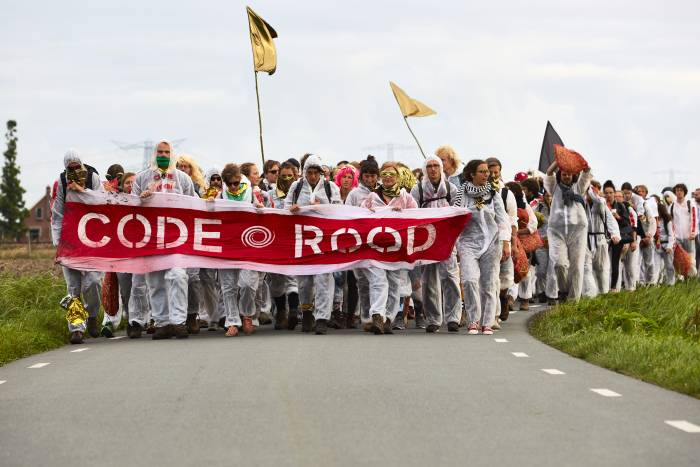
Code Rood activists on their way to blockade a gas facility in Farmsum near Groningen. Photo: Pierre Crom
Once at the site of the blockade the atmosphere was almost festival like. Within an hour the infrastructure needed to support as many people to stay as long as possible (or until it made sense to leave) arrived. We started to build up the impromptu camp.
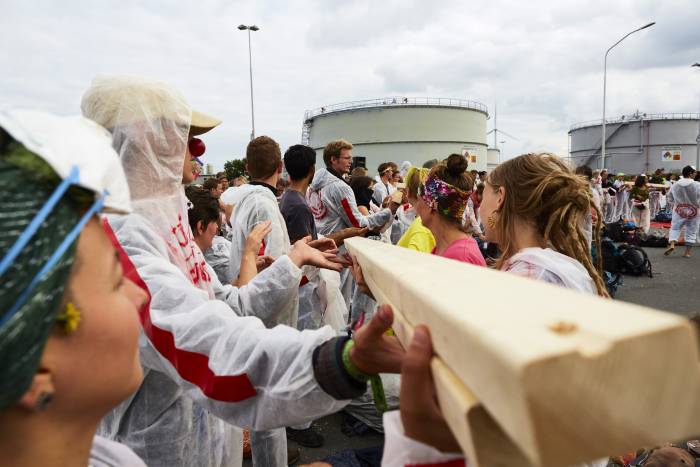
Setting up the blockade of the Farmsun gas terminal near Groningen. Photo: Pierre Crom
One striking difference from similar mass actions was that the police presence at the camp and the site of the blockade seemed relatively limited in numbers and they showed little interest in stopping us. This was an alien situation that left some, including myself, feeling confused as to what impact we were having, since we were prepared for confrontation. However, it quickly became clear that the reality was that we had achieved our tactical goal – in this case reaching and blocking the gas terminal.
(function(d, s, id) { var js, fjs = d.getElementsByTagName(s)[0]; if (d.getElementById(id)) return; js = d.createElement(s); js.id = id; js.src = ‘https://connect.facebook.net/en_US/sdk.js#xfbml=1&version=v3.1’; fjs.parentNode.insertBefore(js, fjs);}(document, ‘script’, ‘facebook-jssdk’));
Code Rood – for Groningen and the climate!
Yesterday, people from Groningen, together with people from all over Europe, joined forces to block Europe’s largest gas field.Gisteren hebben mensen uit Groningen, samen met mensen uit heel Europa, de handen ineen geslagen om Europa’s grootste gasveld te blokkeren.
Posted by Code Rood on Wednesday, August 29, 2018
The action also achieved significant media attention and the (initial) absence of conflict on this occasion created space for strong organisational structures. That in turn helped facilitate collective decision-making processes about what should happen next, and that those decisions were based on a thought-through strategy with a clear goal. In this case building trust and connectedness with the local community was equally, if not more important. We wanted to make sure that we left the blockade at a time and in a manner determined by us, and in support of the ongoing struggle for justice of the local community.
What is this struggle really about?
Since the gas fields began operating conservative estimates suggest somewhere around €300bn worth of gas have been extracted from the Groningen gas fields (the biggest gas field in Europe). Only a tiny fraction of that has benefited the local community. More than 100,000 homes remain unstable and dangerous. Of those that are meant to be okay, through structural support and the like, large numbers of the community live in fear that at any time the walls of their house can literally fall in. It’s hard to even start to imagine what impact living in that level of fear and uncertainty might have on people.
It’s understandable that people are angry and desperate. For many it feels like there is no way out. A sense that they have been completely left behind, sacrificed by the government and the people that are meant to represent them, for profits for a handful of executives.
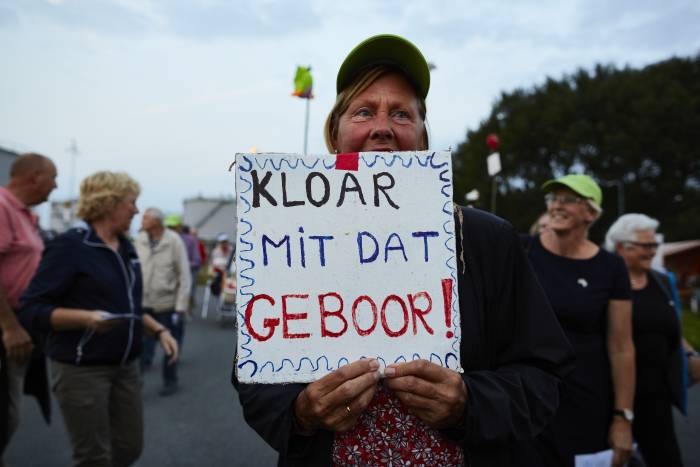
‘Done with the drilling’ sign in the Groningen dialect. Photo: Pierre Crom
In that respect, perhaps the most important impact of the Code Rood camp and action was that it created a sense of hope. The realisation that existing power structures behind the continued extraction of gas and erosion of the local communities’ wellbeing will only ever support business as usual. It felt as though there was an unfolding realisation that if people want justice, they can not only demand it. They can act to claim the space that is needed to guarantee it is delivered.
After the action, the Groninger Bodem Beweging, a group of more than 4,000 people who are directly impacted by the gas extraction in Groningen, thanked Code Rood for organising the camp and action, and emphasised that they enjoy their full support.
And that is the beauty of such an action. The realisation that when we come together and demonstrate power in a way that threatens the status quo, suddenly things can start to shift.